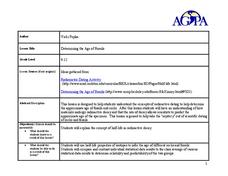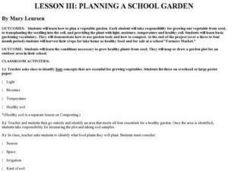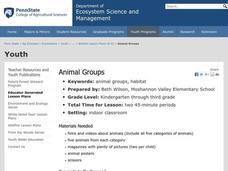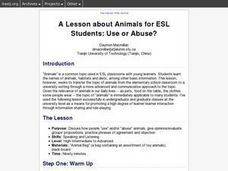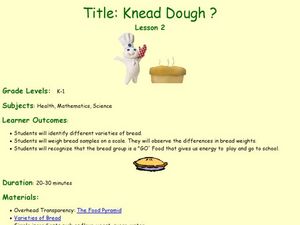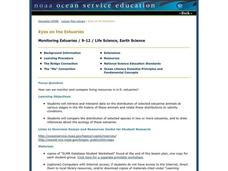Curated OER
Determining the Age of Fossils
High schoolers examine the concept of radioactive dating. In this radioactive dating lesson, students investigate how to determine the ages of fossils and rocks as they learn about half-life radioactive decay.
Curated OER
Planning A School Garden
Learners discover how to plan a vegetable garden. Each student take responsibility for growing one vegetable from seed, to transplanting the seedling into the soil, and providing the plant with light, moisture, temperature and healthy soil.
Curated OER
Animal Groups
Young scholars explore animal groups. In this animal science lesson, students use pictures from magazines and classify the animals into five categories. Young scholars share why they categorized the animals the way they did.
Curated OER
Dinosaur Paleoecology: Determining the Diet of Ancient Animals
Students study dinosaur teeth and bones to determine the creatures diet, size and shape.
Curated OER
What Makes up an Ecosystem?
Eighth graders design posters of working ecosystems using pictures from magazines. They label autotrophic, heterotropic, or saprotrophic energy sources, and identify predators and prey.
Curated OER
Exploring Careers in Aviation
Students investigate various careers in the field of aviation in this lesson. They watch and discuss a video, develop a list of careers in aviation mentioned in the video, and create a resume and cover letter for an entry level aviation...
Curated OER
Finding Caterpillars
Young scholars examine how animals protect themselves from predators and camouflage themselves. They participate in a simulation in which they locate red and green yarn "caterpillars," organize their data, and generate a bar graph using...
Curated OER
Amber Waves of Grain
In this health and diet worksheet, students answer eight true or false questions about wheat. They also list three hands-on activities for their school projects. answers to the true or false are provided.
Curated OER
Check Out Lights and Shields with Beads
Students explore Ultraviolet detecting beads and conduct several investigations with them. In this investigative lesson students participate in an experiment to see the harmful effects of UV light and discuss their findings.
Curated OER
Team Teaching - Spanish
Pupils present a Spanish grammar topic to the class. In pairs, they select and research a grammar concept, create an over-head transparency, homework assignment, and a quiz to use with the presentation, and teach their concept to the...
Curated OER
Exploring Community History and Cultural Influence
Learners explore cultural attributes. In this cultural diversity lesson, students define culture and discuss the diversity of culture that exists in the world. Learners determine whether or not there is an American culture.
Curated OER
Two-Dimensional and Three-Dimensional Shapes
First graders explore 2-dimensional and 3-dimensional shapes. In this geometry lesson, 1st graders examine the attributes of 2 -dimensional and 3-dimensional shapes. They also create the shapes as they build models. This lesson...
Curated OER
A Lesson about Animals for ESL Students: Use or Abuse?
Students discuss animal care using proper phrases of agreement and objection. They role play and make presentations on their animal studies.
Curated OER
Native American Homelands
Pupils discuss the Navajo, Sioux, and Iroquois tribes, noting their distinctive characteristics. They trace the homeland of each of the tribes on maps and create map keys. Students explain how they developed their map keys.
Curated OER
The Life Cycle of the Butterfly
Second graders study the life cycle of a butterfly by observing metamorphosis taking place in a butterfly pavilion. Students illustrate their understandings of the body parts of a caterpillar and butterfly, as well as the life cycle,...
Curated OER
Scales, Scutes, and Skins
Students identify the various adaptations of reptiles and amphibians. After distinguishing between reptiles and amphibians, students discuss the ways in which their adaptations aid in their survival. They participate in a hands on...
Curated OER
Life of a Logger
Young scholars are introduced to the work and lives of 19th century lumberjacks through a living history slide show presentation. They compare and contrast life 150 years ago with the present. Students describe the history of logging in...
Curated OER
Knead Dough?
Young scholars make bread and understand that bread gives us energy. In this bread lesson plan, students read the story A Trip to the Market, and learn about the importance of bread. Then they make the bread!
Curated OER
Winter Survival
Students examine what animals need in order to survive. In this investigative lesson students play a "role" of an animal in winter.
Curated OER
Because of Winn Dixie: Water Management Practices
Fourth graders read the book Because of Winn Dixie and define the characters, setting, and plot. In this Winn Dixie lesson plan, 4th graders also identify quality water management techniques addressed in the story.
Curated OER
The Achievements of the Sumerian Empire
Sixth graders identify four achievements of the Sumerians. They explain the importance of the inventions. They write about a Sumerian invention.
Curated OER
Eyes on the Estuaries
Students study estuaries and compare several ones in the U.S. In this estuary activity students interpret data and compare the distribution of different species.
Curated OER
The Me Book
Students relate to the pictures as symbols so that they come to point to named pictures, explain what pictured objects are for, match pictures to real objects, categorize objects, and recognize words.
Curated OER
Celebrating Diversity
Students celebrate diversity. In this cultural differences lesson, students use their research skills to create a Venn diagram that compares the beliefs and practices of 2 different cultures that they select.
Other popular searches
- Five Basic Food Groups
- Four Basic Food Groups
- 4 Basic Food Groups
- 5 Basic Food Groups
- Basic Food Groups Free
- 3 Basic Food Groups
- Basic Food Groups Worksheets
